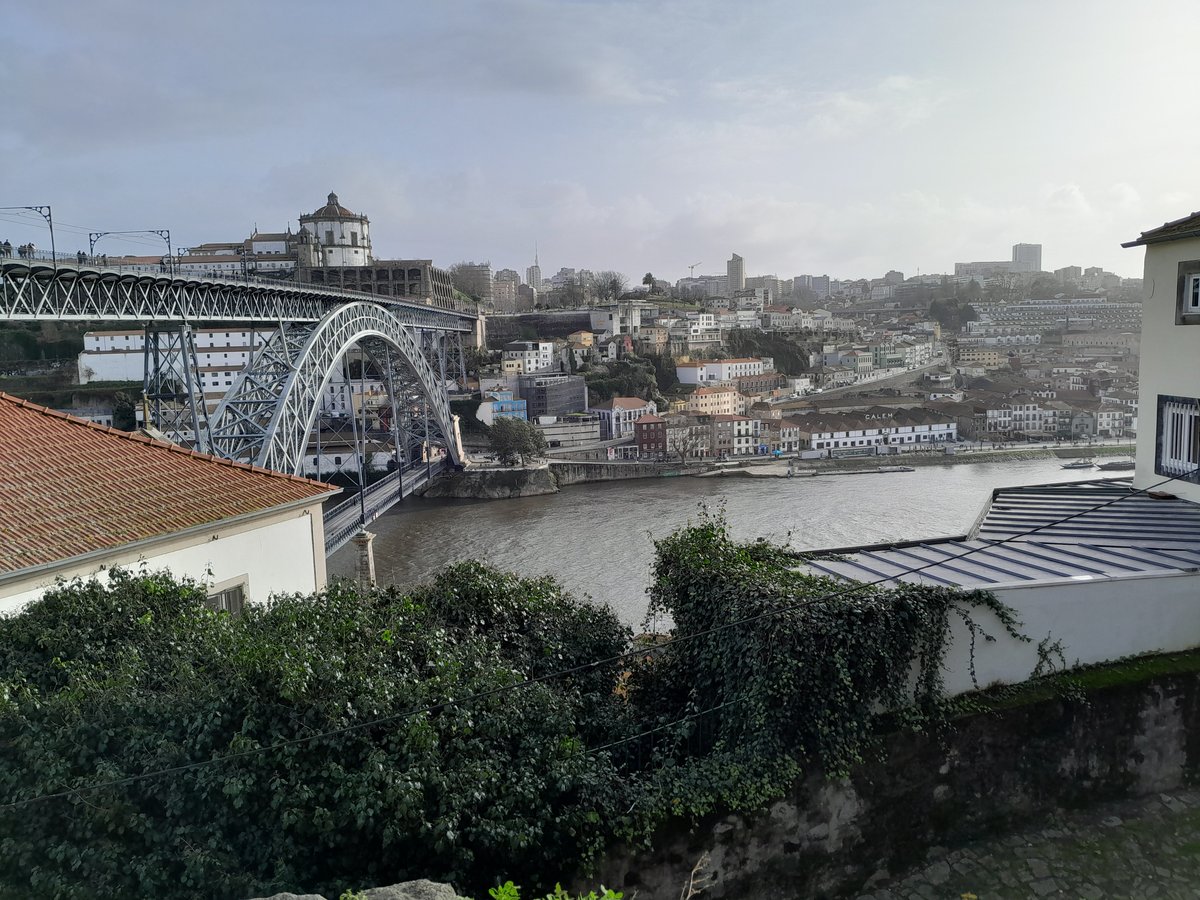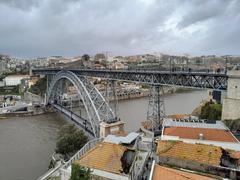
Dom Luís I Bridge: Visiting Hours, Tickets, and Comprehensive Travel Guide to Porto’s Iconic Landmark
Date: 14/06/2025
Introduction: The Enduring Symbol of Porto
The Dom Luís I Bridge is one of Porto’s most recognizable and celebrated landmarks, a masterpiece of 19th-century engineering that elegantly spans the Douro River. Designed by Théophile Seyrig, a disciple of Gustave Eiffel, and completed in 1886, its distinctive double-deck iron arch not only connects the historic Ribeira district with Vila Nova de Gaia but also serves as a vital artery for urban life and tourism. The bridge’s impressive scale, historical significance, and stunning city views make it a central experience for anyone visiting Porto (Visit Porto; Trek Zone; ArchDaily).
Visitors enjoy free, unrestricted access to the bridge’s pedestrian walkways at all hours. The upper deck accommodates both pedestrians and Porto Metro Line D, while the lower deck is shared by vehicles and foot traffic. Its strategic position offers direct access to UNESCO World Heritage sites, renowned port wine cellars, and other notable city landmarks, making the bridge not just a crossing, but a gateway to Porto’s rich cultural heritage.
This guide provides a comprehensive overview of the Dom Luís I Bridge, covering its historical context, architectural features, visitor information, accessibility, practical tips for crossing and photography, and recommendations for nearby attractions and activities.
Contents
- Historical Context and Construction
- Architectural and Urban Significance
- Preservation, Restoration, and Heritage Status
- Visitor Information: Hours, Access, and Tickets
- Accessibility and Safety
- Practical Tips: Best Times, Photography, and Navigation
- Top Nearby Attractions and Activities
- Frequently Asked Questions (FAQ)
- Visuals and Interactive Elements
- Conclusion and Travel Resources
Historical Context and Construction
Porto’s 19th-Century Growth
By the late 19th century, Porto was experiencing rapid industrialization and urban expansion. The Douro River, while crucial for commerce, posed a barrier to efficient movement between Porto and Vila Nova de Gaia. Earlier crossings—the 1806 Ponte das Barcas (a pontoon bridge) and the 1877 Maria Pia Bridge (railway-only)—were inadequate for growing road and pedestrian traffic (Visit Porto).
Design Competition and Realization
To address the need for a modern crossing, the city launched an international design competition in 1879. The winning design, by the Belgian Société Willebroeck under the leadership of Théophile Seyrig, proposed an innovative double-deck iron arch bridge. Seyrig’s experience as co-designer of the Maria Pia Bridge and his mastery of iron construction were instrumental in realizing the ambitious project (Atlas Obscura).
Construction began in 1881 and the bridge was inaugurated on October 31, 1886. With a main span of 172 meters (then the world’s longest iron arch), the bridge immediately became a symbol of Porto’s modernization and engineering prowess (Porto Tourism).
Architectural and Urban Significance
Structural Features
- Main Span: 172 meters (564 feet)
- Total Length: 385.25 meters (1,264 feet)
- Arch Height: 44.6 meters (146 feet)
- Materials: Wrought iron, constructed with riveted techniques for strength and flexibility (Structurae)
Double-Deck Design
- Upper Deck: Now used by Porto Metro Line D and pedestrians, offering sweeping city views.
- Lower Deck: Designed for vehicles and pedestrians, providing direct access between the city’s riverside districts.
The bridge’s slender, lattice ironwork and soaring arch create an iconic silhouette, harmonizing with the historic urban landscape and enhancing Porto’s dramatic skyline (ArchDaily).
Urban Integration
The bridge is more than an engineering feat; it is woven into Porto’s urban identity. It physically and symbolically links the UNESCO-listed Ribeira district with the port wine lodges of Vila Nova de Gaia. Its adaptability—transitioning from horse-drawn carts to trams, then to modern metro and road vehicles—demonstrates its enduring relevance (Porto Metro).
Preservation, Restoration, and Heritage Status
Recognized as a National Monument of Portugal, the Dom Luís I Bridge is protected as part of Porto’s UNESCO World Heritage designation (Direção-Geral do Património Cultural). The structure has undergone several restorations, most notably the 2003 adaptation of the upper deck for exclusive metro and pedestrian use. These efforts ensure the bridge retains both its historical character and functionality for future generations.
Visitor Information: Hours, Access, and Tickets
- Pedestrian Access: Both upper and lower decks are open 24/7, year-round, free of charge.
- Metro: Line D (Yellow Line) crosses the upper deck with stations at São Bento (Porto side) and Jardim do Morro (Gaia side).
- Guided Tours: Various local operators offer walking tours that include the bridge, often in combination with nearby districts and port wine cellars.
No ticket is required to visit or cross the bridge on foot. Metro, funicular, cable car, and river cruise rides require tickets.
Accessibility and Safety
Pedestrian and Mobility Access
- Upper Deck: Accessible by stairs, ramps, or elevators near Porto Cathedral and Jardim do Morro. The upper deck offers the most dramatic views but can be windy and crowded (Trek Zone).
- Lower Deck: Wheelchair accessible and generally less crowded; suitable for those with limited mobility (Disabled Tours).
- Funicular dos Guindais: Offers a scenic link between Ribeira and upper Porto (€2.50 one way). The Teleférico de Gaia (Cable Car) provides easy access between Gaia’s riverfront and upper terrace (€6 one way).
Safety Tips:
- The bridge is well-lit at night and equipped with safety railings.
- On the upper deck, pedestrians share space with the metro—always stay within designated walkways.
- The approach from both sides can be steep and cobbled; wear sturdy shoes and be mindful in wet conditions.
Practical Tips: Best Times, Photography, and Navigation
- Best Times: Early mornings and sunset offer optimal lighting and fewer crowds (Destination Abroad).
- Photography: Top vantage points include the upper deck, Serra do Pilar Monastery terrace, and the Gaia riverside. Nighttime brings spectacular bridge illumination (Lisbon Guide).
- Weather: The bridge is exposed to wind and rain—bring suitable clothing.
- Transport: Public transport is recommended for easy access; parking nearby is limited.
Top Nearby Attractions and Activities
Historic and Cultural Sites
- Ribeira District: Porto’s vibrant UNESCO-listed waterfront with restaurants and colorful facades.
- Vila Nova de Gaia: Home to famous port wine cellars offering tastings and tours.
- Porto Cathedral (Sé): A short walk from the upper deck, featuring Romanesque architecture and panoramic city views.
- Serra do Pilar Monastery: Offers one of the best panoramic viewpoints in Porto.
- São Bento Train Station: Renowned for its azulejo tile murals depicting Portuguese history.
- Clérigos Tower: Climb for unmatched city vistas.
Scenic Experiences
- Six Bridges Cruise: River cruises departing from Ribeira, passing under Porto’s iconic bridges.
- Gaia Cable Car: Aerial ride with spectacular views of the bridge and riverfront.
- Guindais Funicular: Quick, scenic ascent from Ribeira to upper Porto.
Local Experiences
- Riverside Dining: Enjoy traditional cuisine with bridge views in both Ribeira and Gaia.
- Street Performers and Markets: Especially lively in Ribeira, adding to the city’s charm.
- Walking Routes: Enjoy both decks of the bridge for different perspectives; combine with strolls along the Douro riverbanks.
Frequently Asked Questions (FAQ)
Q: What are the Dom Luís I Bridge visiting hours?
A: The bridge is open to pedestrians 24 hours, every day.
Q: Is there an entrance fee?
A: No, crossing the bridge on foot is always free.
Q: Is the bridge wheelchair accessible?
A: The lower deck is accessible; the upper deck involves stairs but can be reached via elevators (check operational status in advance).
Q: Are guided tours available?
A: Yes, many tours include the bridge and surrounding districts.
Q: What’s the best way to reach the bridge?
A: Take Metro Line D to São Bento (Porto) or Jardim do Morro (Gaia), or walk from central Porto or Gaia.
Q: Can I take photos at night?
A: Yes, the bridge is beautifully lit, offering excellent opportunities for night photography.
Visuals and Interactive Elements
- Include high-quality images of the bridge from various viewpoints, such as the upper deck, Gaia riverside, and Serra do Pilar terrace, with descriptive alt tags like “Dom Luís I Bridge panoramic view at sunset” and “Dom Luís I Bridge illuminated at night.”
- Interactive map: Highlighting the bridge, metro stations, funicular, cable car, Ribeira, Gaia, and key attractions.
- Links to virtual tours where available.
Conclusion
The Dom Luís I Bridge is far more than a crossing over the Douro—it is a living testament to Porto’s ingenuity, resilience, and beauty. Open at all hours and free to explore, the bridge invites travelers to connect with the city’s past and present, whether on a leisurely stroll, a scenic metro ride, or while savoring a glass of port wine against its iconic backdrop. Plan your visit with these tips, explore the vibrant surroundings, and immerse yourself in the heart of Porto’s heritage.
Call to Action
Ready to experience the Dom Luís I Bridge and Porto’s historical wonders? Download the Audiala app for real-time updates, curated walking tours, and accessibility guidance. Explore our related articles on Porto’s historical sites and follow us on social media for the latest travel inspiration and insider tips.
References and Further Reading
- Dom Luís I Bridge in Porto: Visiting Hours, Tickets, and Historical Guide, 2025, Visit Porto (Visit Porto)
- Dom Luís I Bridge Porto: Visiting Hours, Accessibility, and Historical Significance, 2025, Trek Zone (Trek Zone)
- Dom Luís I Bridge: Architectural Analysis, 2025, ArchDaily (ArchDaily)
- Dom Luís I Bridge: Structural Details, 2025, Structurae (Structurae)
- Dom Luís I Bridge: Cultural and Urban Significance, 2025, Portugal Getaways (Portugal Getaways)
- Dom Luís I Bridge: Preservation and Heritage Status, 2025, Direção-Geral do Património Cultural (Direção-Geral do Património Cultural)
- Visitor Experience and Practical Tips for Dom Luís I Bridge, 2025, Jermpins (Jermpins)
- Dom Luís I Bridge and Urban Integration, 2025, Portugal Getaways (Portugal Getaways)
- Dom Luís I Bridge and Accessibility, 2025, Disabled Tours (Disabled Tours)
- Top Nearby Attractions and Activities Near Dom Luís I Bridge, 2025, City Guide Porto (City Guide Porto)









































